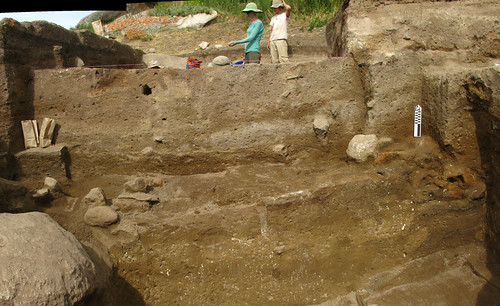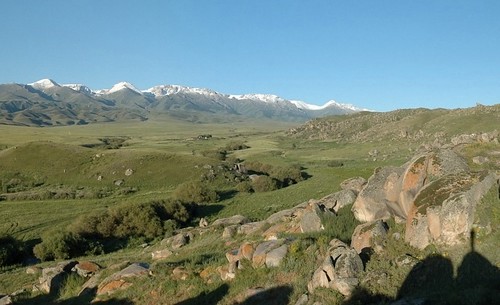Findings at ancient nomadic campsites in Kazakhstan push back earliest known East-West interaction along Slik Road by 2,000 years.
Charred grains of barley, millet and wheat deposited nearly 5,000 years ago at campsites in the high plains of Kazakhstan show that nomadic sheepherders played a surprisingly important role in the early spread of domesticated crops throughout a mountainous east-west corridor along the historic Silk Road, suggests new research from Washington University in St. Louis.
"Our findings indicate that ancient nomadic pastoralists were key players in an east-west network that linked innovations and commodities between present-day China and southwest Asia," said study co-author Michael Frachetti, PhD, an associate professor of archaeology in Arts & Sciences at Washington University and principal investigator on the research project.
Findings are based on archaeobotanical data collected from four Bronze Age pastoralist campsites in Central Eurasian steppe/mountains: Tasbas and Begash in the highlands of Kazakhstan and Ojakly and Site 1211/1219 in Turkmenistan.
Frachetti and a team of WUSTL researchers led the on-site excavations, working closely with archaeologists based in Turkmenistan, Kazakhstan and Italy. Spengler conducted the paleoethnobotany laboratory work at WUSTL, under the directorship of Gayle J. Fritz, PhD, professor of archaeology and expert in human-plant relationships.
__________________________
 A photo of the long-term settlement stratigraphy at the site of Tasbas. Mudbrick/clay oven (visible on right lower portion) contained earliest evidence for grain farming. Credit: Paula Doumani /Washington University in St. Louis (2011
A photo of the long-term settlement stratigraphy at the site of Tasbas. Mudbrick/clay oven (visible on right lower portion) contained earliest evidence for grain farming. Credit: Paula Doumani /Washington University in St. Louis (2011
______________________________
A view of the Byan Zhurek valley and setting near Tasbas. Credit: Michael Frachetti/Washington University in St. Louis (2011)
_____________________________
Frachetti said that ancient wheat and broomcorn millet, recovered from the sites "show that prehistoric herders in Central Eurasia had incorporated both regional crops into their economy and rituals nearly 5,000 years ago, pushing back the chronology of interaction along the territory of the 'Silk Road' more than 2,000 years."
While these crops have been known to exist much earlier in ancient China and Southwest Asia, finding them intermingled in the Bronze Age burials and households of nomadic pastoralists provides some of the earliest concrete signs for east-west interaction in the vast expanse of Eurasian mountains and the first botanical evidence for farming among Bronze Age nomads.
Bread wheat, cultivated at least 6,000 years ago in Southwest Asia, was absent in China before 2500 B.C. while broomcorn millet, domesticated 8,000 years ago in China, is missing in southwest Asia before 2000 B.C. This study documents that ancient grains from eastern China and southwest Asia were present in Kazakhstan in the center of the continent by 2700-2500 B.C. (nearly 5,000 years ago).
"This study starts to rewrite the model for economic change across Eurasia," said first author Robert Spengler, PhD, a paleoethnobotanist and research associate in Arts and Sciences at WUSTL. "It illustrates that nomads had diverse economic systems and were important for reshaping economic spheres more generally."
"Finding this diverse crop assemblage at Tasbas and Begash illustrates first evidence for the westward spread of East Asian and Southwest Asian crops eastward, and the surprise is that it is nomads who are the agents of change," Frachetti said.
The study is published April 2nd in the Proceedings of the Royal Society B.
_____________________________________
Source: Edited from a Washington University press release.
Washington University co-authors include three anthropology graduate students: Paula Doumani, Lynne Rouse and Elissa Bullion. Doumani led the excavations at Tasbas in Kazakhstan while Rouse co-led the excavations at Ojakly in Turkmenistan.
Other co-authors are Barbara Cerasetti, of the Universita`degli Studi di Bologna, Italy, and Alexei Mar'yashev, of the Institute of Archaeology in Kazakhstan.
Funding was provided by National Science Foundation grant nos. 1010678, 0535341, 1132090 and 1036942, as well as Lambda Alpha National Honor Society, the Mary Morris-Stein Foundation, Wenner-Gren grant no. 8157, George F. Dales Foundation and International Research & Exchanges Board IARO.

No comments:
Post a Comment